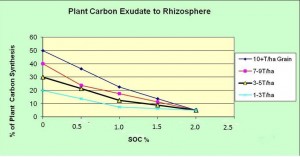Plant liquid carbon pathway works against grain yield in low organic matter soils
By Patrick Francis
An interesting scenario for many cropping paddocks as a result of two years of above average rainfall is being forecast by a farm consultant. Ken Sharpe was until recently employed by a commercial company as a cropping agronomist. He now has his own consultancy. Sharpe was finding an increasing divide between what his former employer was advocating for crop productivity and his personal knowledge surrounding the importance of increasing the labile (short term or available to microbes with the growing season) soil organic carbon (SOC) levels.

As an employee Sharpe was engaged not only to advise farmers but also sell fertilisers. His experience with farmer client Bill Smits Rochester Victoria demonstrated that on this particular farm applying more fertilisers was not the answer to lifting crop yields while maintaining soil health.
“Crop responses to fertiliser are stagnant and declining in many paddocks and increased fertiliser inputs are required just to maintain current yields. This is especially the case where organic carbon levels have dropped. It is becoming more apparent that labile soil organic carbon levels are the critical factor in achieving higher yields and improving fertiliser efficiency,” Sharpe says.
He is concerned that in many cropping paddocks with already lowSOC(less than 1% carbon or less than 2% organic matter) the extended wet period of 2010-11 has resulted in the total mineralisation of what organic matter is left.
“This will be seen in following years as soils with reduced water holding capacity and soils with a poor and cloddy structure and a higher requirement for chemical fertiliser. With current farming practices it will take many years to rebuildSOCto adequate levels and this will have serious consequences for crop yield.”
Sharpe contends that increasedSOClevels are needed to improve crop yields. The benefits ofSOCare accepted to be:
- Improved soil structure for root growth and water infiltration
- Increased water holding capacity
- More available nutrients from recycled organic matter.
But Sharpe believes there is a fourth benefit generated from liquid carbon compounds exuded by plants into the rhizosphere (the few mm of soil surrounding fine roots).
“Microbes feed on this carbon energy source which results in a localised acidic zone. This acidification acts to solubilise nutrients from the soil for plant growth. Interestingly, plants respond to low soil carbon situations by exuding more plant synthesised carbon, this is sometimes referred to as liquid carbon.
“We have all seen the extraordinary growth in sections of paddocks where organic matteris higher and wish for the whole paddock to be the same. Understanding howSOC improves plant production will help to raise its importance in managing crop nutrition,” he says.
Plant dry matter composition
Sharpe says conventional inorganic fertiliser is important to supply the basic and limiting nutrients required by our food crops. The focus on them should not be exclusive however and must be put into some perspective.
“The elemental nutrients NPKS we apply are only 4% of dry matter composition. They are important for the plant synthesis of hydrogen (6%) and the oxygen (48%) fraction of plant dry matter (DM) which are synthesised from both the atmosphere and from water. Water will continue to be a major limitation to yield”.
The carbon content of cereal crops (42%) is a primary building block of plant structure and yield and this element must be sourced almost totally from the atmosphere, that is from photosynthesis.
The low carbon composition of the atmosphere (~0.0094% C or 0.035% CO2) means that carbon is an expensive element for the plant to synthesise. The process of photosynthesis and respiration is inefficient and any management that can improve carbon allocation to plant growth must be considered.
Plant carbon must be synthesised from the atmosphere to build plant dry matter (DM). The next greatest source of carbon is in the soil from recycled plant material that is, SOC. This is the resource Sharpe says farmers can manage. It is important to understand that plant growth continues to improve as SOCincreases towards 2-2.5%.
Most farmers recognise thatSOCresults from dead plant residue and root material returning to the soil each season but don’t know about it coming from plant root exudation, that is the liquid carbon source. The importance of this factor is totally overlooked in understanding crop nutrition.
Plant research papers quote the plant carbon allocation to the rhizosphere is between 5 – 50% of total synthesised carbon.
“This carbon is a loss to potential yield. No other factor offers farmers the chance to improve productivity by this amount. It represents a potential loss of productivity because what goes into liquid carbon could have been allocated to the plant itself, especially for above ground growth and grain and is an overlooked factor in raising crop water use efficiency and fertiliser efficiency.”
Two questions immediately arise about root exudation of soluble carbon:
- Why does the plant allocate carbon through roots?
- Why does the amount of this carbon allocation vary so much?
At the growing tip of each root is an area where the plant interacts with the soil. Plant carbon is exuded through this tip as the root grows through the soil profile. Microbes feed on this liquid carbon and the populations of microbes quickly increase to consume it.
The result of this biological activity is (generally) an area of increased acidification (~pH3.7 from carbonic acid). This acidification of the soil zone solubilises and releases nutrients in the elemental form. Sharpe says these nutrients are over and above the nutrients released through biological decomposition of organic matter.
New nutrient source
“These are new nutrients to the crop nutrition equation and the basis of plant production on earth for millions of years. Farmers should request a Total P measurement on their next soil test to determine accessible background levels of phosphorus. This total soil phosphorus is accessible when labile SOC levels are at 2-2.5%.
“Fertiliser is applied to supply a source of nutrients for non-limiting plant growth. As the roots explore soil away from this concentrated fertiliser band the rhizosphere must still continue to allocate liquid carbon away from plant growth and productivity. Farmer trials should compare sites with different SOC levels to establish crop productivity and fertiliser efficiency.
“From many years of personal observation of commercial production and of plant and fertiliser response trials a correlation between SOC and plant productivity is clear and evident. Crops grown with lower SOC (<2%) levels tend to require more fertiliser and more growing season water than adjoining crops grown on “healthier” soil,” he says.
Artificial fertiliser increases the availability of elemental nutrients for crop production and supplies the soil bank with nutrients that can be deficient. Plant uptake of these fertiliser applied nutrients, such as phosphorus, is only partial in the year of application.
Where high levels of labile (biologically digestible) SOC exists; the action of soil biological feeding is to release soil bound nutrients so they are available for plant uptake. This occurs in all production systems as roots explore the soil zone away from the concentrated fertiliser band.
Where SOC is very low (<1%) the plant must compensate with significantly increased exudation of liquid carbon to feed the soil biology; to then solubilise soil bound nutrients for plant uptake.
Quantifying the production effect of SOC
Sharpe says his review of plant physiology research suggests that liquid carbon exudation can be 5-30% of plant synthesised carbon for 3-5T/ha crops (equivalent to 8-12T/ha total DM production above ground). Higher yielding crops can exude 30-50% liquid carbon (25T/ha total DM production above ground). This greater amount is probably a function of a faster growth rate and a longer growing season.
“ My communication with researchers such as Dr P. Syltie (USA) suggests that while these enormous levels of exudation have been measured the association with SOC levels has not been made,” he says.
“Canadian research quoted in GRDC literature has found fertiliser inputs compared to crop production has poor efficiency (kgs elemental nutrient applied compared to kgs of elemental nutrient exported) in soils with less than 2-2.5% SOC. Soil with less than 1% SOC has extremely poor fertiliser and production efficiency. A level of 2% SOC also seems to be the figure used by international researchers to designate a soil as ‘healthy’”.
Combing this information begins to put meaningful numbers on crop production and SOC, figure 1.

Sharpe says as labile soil carbon increases from 0 to 2% the soil microbes have an increasing carbon feed source that will release soil nutrients that are adequate for crop production. Where SOC is less than 2% the plant must allocate more liquid carbon to the rhizosphere. This allocation of carbon, on the y axis, is a loss to dry matter production in that year. In the second year of growth the soil carbon is increased and yields will be higher.
“From the scientific literature it appears 3-5T/ha grain crops allocate up to 30% liquid carbon in a low SOC situation and high yielding cereals(10T/ha+) can exude up to 50% of plant synthesised liquid carbon.”
He says farmers should use these trend lines in figure 1 to quantify the potential reduction in productivity between two sites with differing SOC. It allows farmers to start putting a yield response onto SOC versus applying more fertiliser or water.
Where low SOC (<2%) exists plants must exude more liquid carbon to grow and yield. To achieve similar production levels to a higher SOC site there appears to be a requirement for using higher rates of phosphorus to speed plant growth rates.
Higher phosphorus availability increases the speed of plant functioning. A crop on a low SOC must grow faster and requires more phosphorus to achieve an equivalent yield to a high SOC crop paddock. The export of phosphorus in the grain remains the same for both situations although higher inputs are needed on the low SOC site.
“To maximise P availability to growing crops and pastures the farmer should focus on raising soil pH to around 6 (in CaCl2) and the SOC (above 2%),” Sharpe says.
But there is another important point about the type of carbon in the soil.
“The standard soil tests for SOC can give a total carbon number which includes unavailable char. To be able to manage and understand SOC it is important to monitor and measure only labile carbon levels.”
Labile carbon is the short term carbon formed from current crops or pasture dry matter that is readily decomposed by soil microorganisms, it is distinctly different from long-term carbon such as biochar which depending on its source can survive in the soil for decades or even centuries.
New tests based on potassium permanganate will allow farmers to sample and test for labile carbon only. This test is a good indicator of climate resilience, that ise. the ability to respond to rainfall. It might even show that two landscapes with an identical SOC test are not similar. The test is currently $20+gst and offers an alternative to more frequent measuring of SOC without the higher cost of the usual full nutrient test kit.
Microbes will use excess nitrogen to digest organic matter and SOC before it becomes available for plant use. This will create a situation of high fertility and plant response in the immediate term but will also burn up and lower SOC levels in the longer term. This means when using nitrogen it should be applied to match crop demand to minimise excess burn up of SOC.
“The expense of building SOC levels will be wasted where nitrogen rates in excess of crop demand are applied and microbial digestion increases,” Sharpe says.
Take home message
Liquid carbon is exuded by the plant roots to access soil bound nutrients. Higher labile SOC results in increased microbial feeding to also release soil bound nutrients.
Where 2-2.5% labile SOC exists, enough microbial feeding occurs to solubilise soil bound nutrients so that plants will exude less liquid carbon to the soil to access these same nutrients. This plant carbon can then be used for significantly increased plant growth and function.
Find out more
Ken Sharpe 0427 466 955, kenpcspakistan@hotmail.com
Key points to managing soil organic carbon
- Target a minimum 2% SOC (labile).
- As a rule of thumb this is 20T/ha in the top 100mm.
- Plant material has about 42% carbon content
- Animal manures have about 18% carbon content.
- Residue left on the soil surface contributes little to SOC
- Incorporation of crop residue, green and brown manure crops should be used strategically when SOC drops below the planned level.
- Less than 1% SOC will yield poorly.
- Cultivation with no organic matter destroys soil structure however cultivation to incorporate organic matter will improve soil structure.
- Incorporated organic matter must be decomposed before seeding a new crop.
- Livestock grazing in the rotation can improve SOC.




Can this liquid carbon that companies want to pipe across farm land be incorporated into the soil to improve soil rather than wasting it in deep caverns underground
Don cuthbet at
1don.cuthbert @gmail.com
Hello Donald,
Thanks for the email. The liquid carbon exudates from plant roots refers to sugars produced by the plants. My understanding of carbon capture and storage, is a process capturing CO2 and storing it deep underground so it cannot escape into the atmosphere. The two processes are different and operating at vastly different depths below the soil surface.